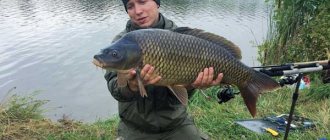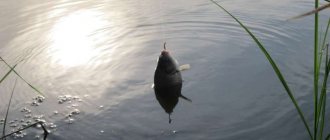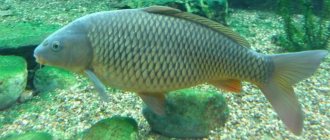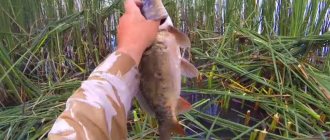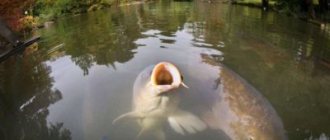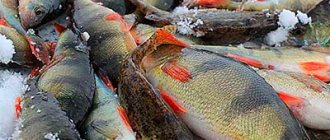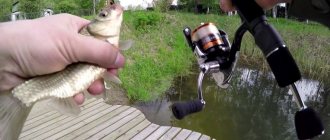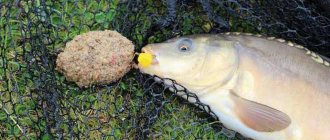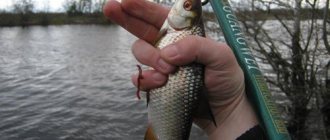Carp 09/04/2020
412
Spring is becoming a long-awaited and favorite time of year for many fishermen. It's time to open the open water fishing season. It is quite difficult to successfully fish on the rivers at this time. Largely due to the high water level. But you can go to the lake to catch crucian carp that has just awakened from sleep.
The optimal place for spring fishing for crucian carp is the lake
Features of spring carp fishing
Carp (carp) is a heat-loving fish, its activity and bite largely depend on water temperature. When other fish of the carp family are fattening up after winter, the carp is just beginning to “wake up”. For central Russia, May is the month of the beginning of activity in spring fishing for carp and carp. To the south, you can start catching carp as early as April, but the peak of its activity occurs in June.
Fishing for carp in cold water in spring requires a responsible approach and well-tuned gear. If the carp is not yet very active, you need to try hard to catch it. The winners are the anglers who use the principles of sport fishing.
As the water temperature rises, the carp's bite becomes more expressive, and it responds more readily to the complementary food offered to it. When the water temperature reaches 10 degrees, carp and carp begin to look for places to spawn. In water warmed up to 14 degrees, the carp’s normal metabolism is established and the feeding regime is “turned on.”
A little earlier, similar activity was observed when catching spring crucian carp.
The main feature of spring fishing for carp or carp is that thinner gear and smaller baits are used than in summer fishing. Baits and baits for catching carp in cold water in spring are less nutritious and aromatic (contain less protein and aromatic attractants). Spring carp sites differ from summer ones.
FISHING CARP AND CRUCCIAN IN SPRING
SPRING FISHING FOR CARP AND CRUCCIAN
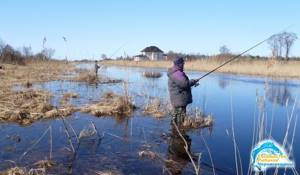
spring fishing
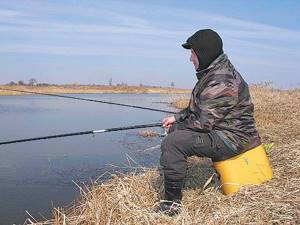
You usually need to go fishing for carp and crucian carp from mid-March. Much depends on good weather. After winter, fish do not wake up immediately, since the water in reservoirs is still cold at the beginning of spring. As soon as the water warms up a little, the crucian carp begins to bite. In spring, everything awakens and crucian carp are no exception. During this wonderful time, fish begin to actively move, looking for food. Determining the location of crucian carp or crucian carp is not difficult. This can be seen by the rising bubbles from the water. March and April are the most suitable spring months for fishing for carp and crucian carp. The angler is required to be patient and find a good bite. Fishermen wait for large fish directly from the shore, since at this time of year they swim up to shallow, warm areas of the shore. Ideally, feed the fish a little, but do not overdo it with bait. After all, the early crucian carp has just woken up and needs to regain consciousness. Using a boat you can catch large fish, since in cold water the fish will stay at a depth far from the shore.
As for crucian carp, it is fickle. This little fish is always on the move. The crucian carp swims in the direction of the school. By the way, during spawning for 2-3 days it will not peck at all. A good bite is only possible on a crucian carp pond, provided that the fishing spot is properly selected - the glue spot. Fishing for crucian carp is a wonderful activity and the best time for this is summer. The very first months of summer - June and July - are most suitable for this. At this wonderful time, the water warms up more and the crucian carp feels comfortable in such water.
Article on the topic: Fishing tactics in small bodies of water
In autumn, fishing for carp and crucian carp may not be effective at all. And, on the contrary, when spring weather persists outside, fishing for crucian carp or carp with delicious bait will definitely be a success. Winter brings its own rules to the behavior of fish. The latter willingly burrows into the mule and finds the necessary parasites there.
It is best to catch carp or crucian carp closer to the reeds, because green grass grows there, which they like to feed on. The depth for fishing should be no more than one and a half meters. Early morning is the best time for effective fishing for crucian carp and crucian carp (usually from 6 to 10 am).
Catching carp in winter is more often of an accidental nature. By chance you can catch another fish from the ice using a jig with bloodworms, maggots or something else.
Article on the topic: How to catch pike perch? Catching zander.
As for crucian carp and its fishing in winter, although it is caught, it is not everywhere and in any weather. In some places its steady bite is observed, in others the crucian carp does not bite all winter. In some weather it bites effectively, in other weather conditions the situation is different.
Cyprinids are heat-loving fish. Where to look for them in winter, and what methods to use to effectively catch them? Is it worth it to engage in winter fishing for crucian carp and crucian carp? Or will he postpone this event until early spring? How to please yourself and your loved ones with stable catches?
Let's answer these questions!
Reservoirs from which information is received about successful fishing of carp fish in winter can be identified.
What bodies of water are suitable for winter fishing for carp and crucian carp?
It is better to immediately exclude reservoirs with unfavorable oxygen conditions. As a rule, such reservoirs are inhabited only by “swamp” inhabitants. Most likely, there will be rotan, tench and frogs.
In such reservoirs there can be a lot of crucian carp, although its number prevails over the number of other fish, but in winter it will not be caught, but will bury itself in the silt and hibernate.
We need bodies of water with a favorable environment, with more than sufficient oxygen levels. A feature of such reservoirs is a rich ichthyofauna. In such reservoirs, the permanent inhabitants are perch, pike perch, chub, bleak, rudd, roach, and bream. As you can see for yourself, the species diversity is very pleasing.
Article on the topic: Pike fishing on the river
Sometimes such reservoirs have a relatively large flow of water and areas where the current is clearly expressed. These can be estuaries where a river flows into them, as well as places confined to the main channel or outlet of springs - this is where there will be the most oxygen and food for fish.
There will definitely be carp and crucian carp in such reservoirs, and winter fishing will greatly please you. You just need to approach fishing correctly - get the fish interested, choose effective bait, use working equipment.
If there is a predator in the reservoir, then this is a factor that speaks in favor of winter fishing. The predator forces peaceful fish to move even in the winter season. This is understandable, because no one wants to be a victim.
Rivers, on the whole, provide us with the best conditions for winter fishing. If the river is rich in carp and crucian carp, then their bite does not stop in wintering areas all year round. In order to successfully fish all winter, you need to know the bottom topography and wintering pits where crucian carp and crucian carp are localized.
Where to fish
The success of spring fishing largely depends on the correct choice of place for carp fishing. So where is the best place to catch carp in the spring, and how to choose a fishing spot?
Carp sticks to quiet places rich in plant and animal food. It happily eats young shoots of reeds and other aquatic plants. In spring, carp comes to the spawning grounds of other fish species, where they happily feast on their eggs and no one can stop them from doing so. Carp linger for a long time in such places, especially if they are suitable for the upcoming spawning.
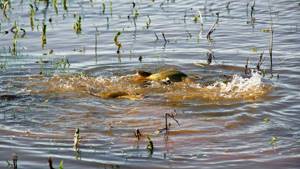
Shallow areas of reservoirs in the middle of aquatic vegetation, where the depth reaches one and a half to two meters, can be considered promising areas for catching carp in the spring.
As the water in the reservoir warms up, the carp begins to visit deeper water areas in search of their favorite shell rock.
However, it is impossible to predict the location of the carp in advance; this is determined during the fishing process. In the spring, carp move quite actively around the reservoir, and where it was caught yesterday, it may not be today.
Catching crucian carp with a float rod in the spring. Fishing with a float
Catching crucian carp in early spring with a float rod has its own characteristics, and there are points that relate specifically to this period of spring fishing, for example, when to start catching crucian carp. After all, the concept “fishing for crucian carp begins in early spring” will not help the fisherman much. In early spring it may be March 1, but it is unlikely that you will return with a catch if you go fishing so early. You need to be patient, wait until the water temperature is favorable for catching crucian carp, so as not to spoil your mood with no bite. Let's find out exactly when you should go fishing for crucian carp in early spring and how it will behave as summer approaches.
Read also: Fishing for crucian carp in autumn
After the winter season, fishing for crucian carp in the spring is most effective in reeds or near reeds, since the water is heated to 12 degrees, crucian carp prefers to be there. The reason for this choice is immediately clear: in the reeds or reeds, the water is 1.5-2 degrees warmer, which is why the fish strive to get there. Also, here, 2 weeks earlier, other living creatures wake up, that is, food for crucian carp. On early spring days, the sun still does not warm up the reservoir very well; it warms up, but not evenly. It shines first on one shore, then on the other, it has been noticed more than once that while you are fishing in an illuminated area, everything is fine, but as soon as the sun stops shining there, and your already favorite place remains in the shade, the bite stops, as if on command. Float, sinker and hook for crucian carp.
Read also: How to choose the right float for fishing conditions
Buying a float that is too large is definitely not worth it. Suitable for medium size, slightly pot-bellied or oblong in shape. For large currents, you need to choose a large, heavy float for a heavy sinker so that they are not pulled by the current.
In general, the choice of float directly depends on the place where you are going to fish. Crucian carp, although more active than roach, still takes quite a long time after a long winter, so you should not overfeed. It is also desirable to have the main bait in the groundbait, albeit in small quantities, but it should be there.
Read also: Fishing for crucian carp in a quarry in winter
As a bait, it would be the best option, before a fishing session, to stop by a fishing store and buy specialized bait and flavoring. The flavor will help you during the no-bite period. You can also make bait at home; for this you will need mixed feed, a little pearl barley porridge and a little imagination.
Pearl barley porridge must be cooked until its grains are very soft to the touch. You can also use sunflower cake as a flavoring agent.
Carp tackle
In 90% of cases, bottom gear is used to catch carp in the spring - this is a classic or carp flat feeder. Only fans of float fishing catch carp using fishing rods with a float.
Often, especially at the beginning of the carp fishing season, the use of thin float gear is very justified. Much depends on the type of reservoir and fishing conditions. However, when the carp move away from the shore, the best results are achieved in feeder fishing.
For spring carp fishing on a feeder, we can recommend using equipment made according to the principle of the flat method or inline installation using floating baits.
Amateur karpolovs use equipment for the feeder with a “plug” or “nipple” feeder or a simple spring, and from the moment the activity of a large carp or carp begins, the “makushatnik” is used.

However, progress does not stand still, and most fishermen have adopted elements of carp rigs from athletes and use method flat feeders.
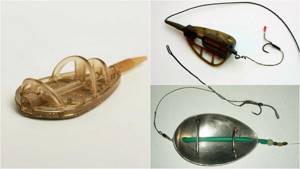
Fishing principle
All feeder rigs for carp fishing with feeders operate on a similar principle:
- The feeder is charged with food, into which a hook with a nozzle is installed;
- Sinking to the bottom after casting, the bait begins to wash out of the feeder, forming an attractive feeding spot;
- Attracted by the aroma of bait, the carp begins to eat food from the feeder, sucking up the bait with a hook.
The floating bait, freed from the food, rises and, as if hovering, becomes very noticeable and attractive to the fish. A floating bait does not always work better than one on the bottom - this becomes clear in the process of catching carp.
Nozzle and bait for carp
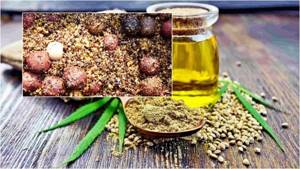
As we have already said, to catch carp in cold water in the spring, you should use bait that is not too nutritious. The main task is not to saturate the carp, but to attract it to the fishing spot. Therefore, the starting feeding for carp is not as plentiful as during summer fishing.
As for the baits, they are almost no different from the summer ones except for their size. Spring baits are smaller and lighter and use appropriate hooks. The colder the water, the more delicate everything is.
Only after the carp spawn, already in June, can you switch to full-fledged food and large-sized baits. Carp spawns in warm water, warmed up to a temperature of 18 - 20 degrees.
